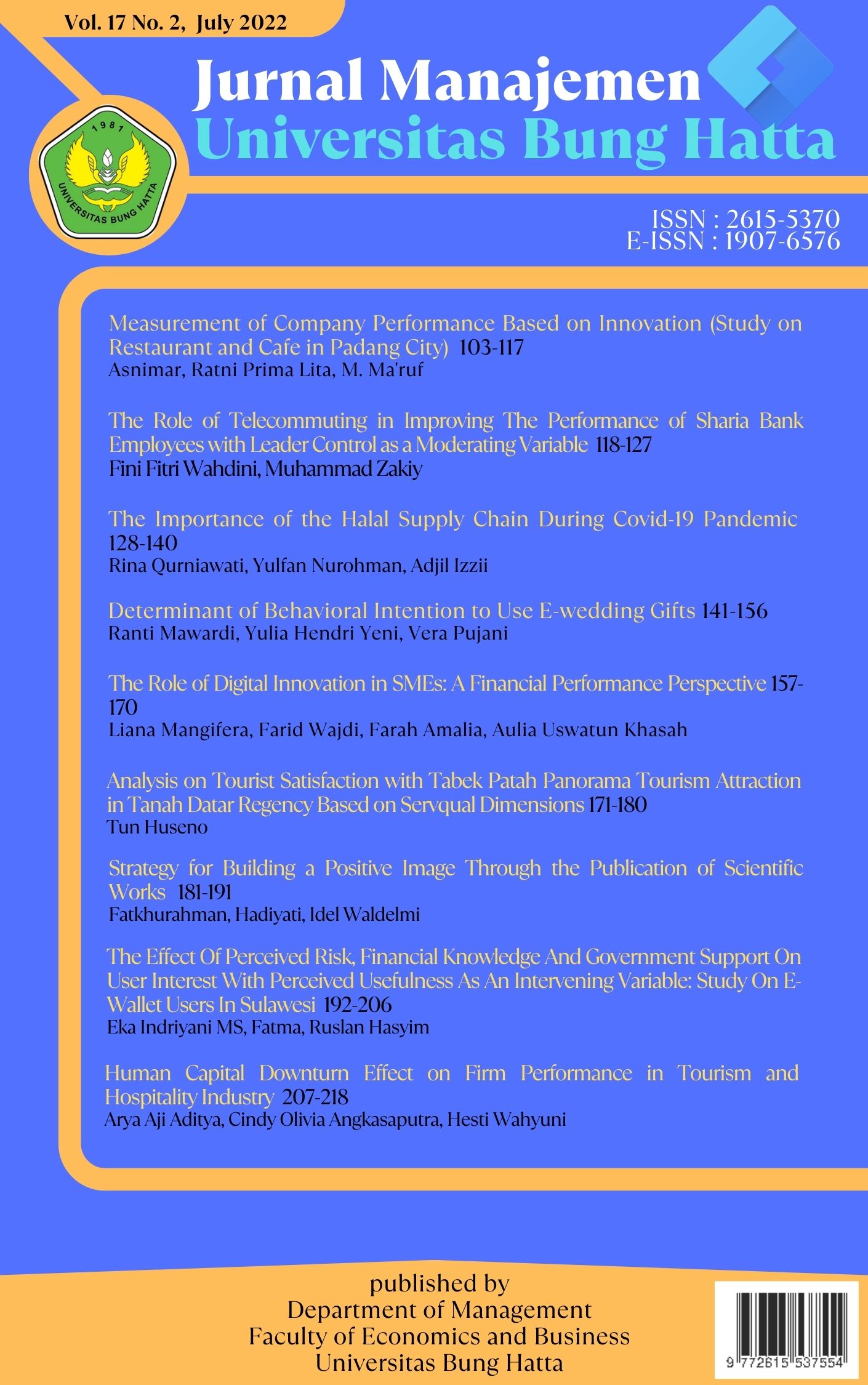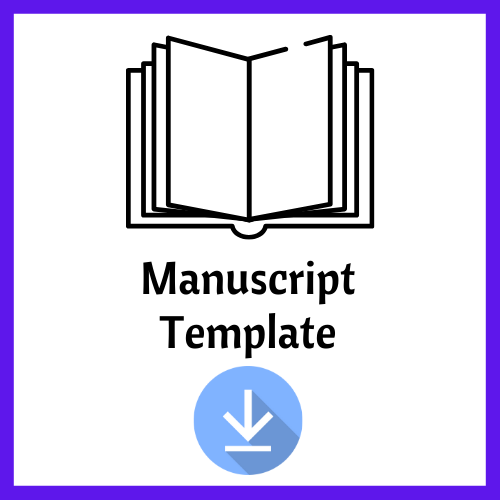Human Capital Downturn Effect on Firm Performance in Tourism and Hospitality Industry
DOI:
https://doi.org/10.37301/jmubh.v17i2.20812Abstract
The objective of this study was to investigate the relationship between human capital and firm performance in the hotel, restaurant, and tourism industry periode 2019-2020. This is quantitative study that provides use of the mutilple linear regression method. The secondary data collection was obtained at www.idx.co.id, including income statement and financial statement notes for period 2019-2020. The analaysis result show that human capital has an effect on a firm performance. Based on the analysis result, we can conclude the COVID-19 pandemic has forced firms to implement human capital strategic planning such as layoffs, voluntary salary reductions, and reduced working hours, all of which have a detrimental effect on firm performance.
References
Albitar, K., Gerged, A. M., Kikhia, H., & Hussainey, K. (2021). Auditing in times of social distancing: the effect of COVID-19 on auditing quality. International Journal of Accounting and Information Management, 29(1), 169–178. https://doi.org/10.1108/IJAIM-08-2020-0128
Alnachef, T. H., & Alhajjar, A. A. (2015). Effect of Human Capital on Organizational Performance: A Literature Review. International Journal of Science and Research, 6(8). https://doi.org/10.21275/ART20176151
Assensoh-Kodua, A. (2019). The resource-based view: A tool of key competency for competitive advantage. Problems and Perspectives in Management, 17(3), 143–152. https://doi.org/10.21511/ppm.17(3).2019.12
Babajee, R. B., Seetanah, B., & Nunkoo, R. (2020). The determinants of hotel financial performance: an intellectual capital perspective. Journal of Hospitality Marketing and Management, 29(8), 1008–1026. https://doi.org/10.1080/19368623.2020.1703870
Barney, J. (1991). Firm Resources and Sustained Competitive Advantage.pdf. Journal of Management, 17(1), 99–120.
Baron, A. (2011). Measuring human capital. Strategic HR Review, 10(2), 30–35. https://doi.org/10.1108/14754391111108338
Baum, T., Mooney, S. K. K., Robinson, R. N. S., & Solnet, D. (2020). COVID-19’s impact on the hospitality workforce – new crisis or amplification of the norm? International Journal of Contemporary Hospitality Management, 32(9), 2813–2829. https://doi.org/10.1108/IJCHM-04-2020-0314
Bontis, N. (2002). The Strategic Management of Intellectual Capital and Organizational Knowledge. Oxford University Press.
Borghouts – van de Pas, I., Bosmans, M., & Freese, C. (2021). Unemployment prevention: The role of Human Resource Management in job-to-job transitions in the event of redundancy. European Journal of Social Security, 23(2), 103–119. https://doi.org/10.1177/1388262721995209
Boxall, P., Purcell, J., & Wright, P. M. (2009). Human Resource Management: Scope, Analysis, and Significance. The Oxford Handbook of Human Resource Management, June 2018, 1–18. https://doi.org/10.1093/oxfordhb/9780199547029.003.0001
Chen, H., & Eyoun, K. (2021). Do mindfulness and perceived organizational support work? Fear of COVID-19 on restaurant frontline employees’ job insecurity and emotional exhaustion. International Journal of Hospitality Management, 94(August 2020), 102850. https://doi.org/10.1016/j.ijhm.2020.102850
Chen, I. S. (2020). Turning home boredom during the outbreak of COVID-19 into thriving at home and career self-management: the role of online leisure crafting. International Journal of Contemporary Hospitality Management, 32(11), 3645–3663. https://doi.org/10.1108/IJCHM-06-2020-0580
Darby, M. R., Liu, Q., & Zucker, L. G. (2004). High stakes in high technology: High-tech market values as options. Economic Inquiry, 42(3), 351–369. https://doi.org/10.1093/ei/cbh066
Davis, P. J. (2017). How HR can create competitive advantage for the firm: Applying the principles of resource-based theory. Human Resource Management International Digest, 25(2), 4–6. https://doi.org/10.1108/HRMID-09-2016-0122
Dewi, M. M., Magdalena, F., Ariska, N. P. D., Setiyawati, N., & Rumboirusi, W. C. B. (2020). Dampak Pandemi Covid-19 terhadap Tenaga Kerja Formal di Indonesia The Impact of Covid-19 Pandemic on Formal Labour in Indonesia. Populasi, 28(2), 32–53.
Farzanegan, M. R., Gholipour, H. F., Feizi, M., Nunkoo, R., & Andargoli, A. E. (2021). International Tourism and Outbreak of Coronavirus (COVID-19): A Cross-Country Analysis. Journal of Travel Research, 60(3), 687–692. https://doi.org/10.1177/0047287520931593
González-Torres, T., Rodríguéz-Sánchez, J. L., & Pelechano-Barahona, E. (2021). Managing relationships in the Tourism Supply Chain to overcome epidemic outbreaks: The case of COVID-19 and the hospitality industry in Spain. International Journal of Hospitality Management, 92(October 2020). https://doi.org/10.1016/j.ijhm.2020.102733
Hair, J. F., Black, W. C., Babin, B. J., & Anderson, R. E. (2014). Multivariate Data Analysis (7th ed.). Pearson.
Hemmington, N., & Neill, L. (2021). Hospitality business longevity under COVID-19: The impact of COVID-19 on New Zealand’s hospitality industry. Tourism and Hospitality Research. https://doi.org/10.1177/1467358421993875
Lee, D., & Choi, B. (2020). Policies and innovations to battle Covid-19 – A case study of South Korea. Health Policy and Technology, 9(4), 587–597. https://doi.org/10.1016/j.hlpt.2020.08.010
Lokadata. (2020). Kontribusi Pariwisata terhadap PDB 2010-2020. https://lokadata.id/data/kontribusi-pariwisata-terhadap-pdb-2010-2020-1609226810
Mahsud, R., Yukl, G., & Prussia, G. E. (2011). Human capital, efficiency, and innovative adaptation as strategic determinants of firm performance. Journal of Leadership and Organizational Studies, 18(2), 229–246. https://doi.org/10.1177/1548051811400750
Ministry of Tourism. (2019). Laporan Kinerja Kementerian Pariwisata 2019.
Ministry of Tourism. (2020). Laporan Kinerja Kementerian Pariwisata dan Ekonomi Kreatif 2020.
Mirza, N., Hasnaoui, J. A., Naqvi, B., & Rizvi, S. K. A. (2020). The impact of human capital efficiency on Latin American mutual funds during Covid-19 outbreak. Swiss Journal of Economics and Statistics, 156(1). https://doi.org/10.1186/s41937-020-00066-6
Ngadi, N., Meliana, R., & Purba, Y. A. (2020). Dampak Pandemi Covid-19 Terhadap Phk Dan Pendapatan Pekerja Di Indonesia. Jurnal Kependudukan Indonesia, 2902, 43. https://doi.org/10.14203/jki.v0i0.576
Pasban, M., & Nojedeh, S. H. (2016). A Review of the Role of Human Capital in the Organization. Procedia - Social and Behavioral Sciences, 230(May), 249–253. https://doi.org/10.1016/j.sbspro.2016.09.032
Price, A. (2007). Human Resource Management in a Business Context (3rd ed.). Thomson Learning.
Pujianto, A., Utami, W., & Sastrodiharjo, I. (2016). Peran Life Cycle Stage Dalam Memoderasi Hubungan Antara Intellectual Capital Disclosure Dan Nilai Perusahaan. Akuntabilitas, 9(1), 121–142. https://doi.org/10.15408/akt.v9i1.3588
Pulic, A. (1998). Measuring the Performance of Intellectual Potential in Knowledge Economy. 2nd McMaster World Congress on Measuring and Managing Intellectual Capital.
Pulic, A. (2004). Intellectual capital – does it create or destroy value? Measuring Business Excellence, 8(1), 62–68. https://doi.org/10.1108/1368304041052475
Rahim, A., Atan, R., & Kamaluddin, K. (2017). Human Capital Efficiency and Firm Performance : an Empirical Study on Malaysian Technology Industry. SHS Web of Conference 36, 26. https://doi.org/10.1051/shsconf/20173600026
Sanders, K., Nguyen, P. T., Bouckenooghe, D., Rafferty, A., & Schwarz, G. (2020). Unraveling the What and How of Organizational Communication to Employees During COVID-19 Pandemic: Adopting an Attributional Lens. Journal of Applied Behavioral Science, 56(3), 289–293. https://doi.org/10.1177/0021886320937026
Singh, M. K., & Neog, Y. (2020). Contagion effect of COVID-19 outbreak: Another recipe for disaster on Indian economy. Journal of Public Affairs, 20(4), 1–8. https://doi.org/10.1002/pa.2171
Smart, K., Ma, E., Qu, H., & Ding, L. (2021). COVID-19 impacts, coping strategies, and management reflection: A lodging industry case. International Journal of Hospitality Management, 94(January), 102859. https://doi.org/10.1016/j.ijhm.2021.102859
Soewarno, N., & Tjahjadi, B. (2020). Measures that matter: an empirical investigation of intellectual capital and financial performance of banking firms in Indonesia. Journal of Intellectual Capital, 21(6), 1085–1106. https://doi.org/10.1108/JIC-09-2019-0225
Storey, J. (2007). Human Resource Management. Edward Elgar Publishing.
Subramaniam, M., & Youndt, M. A. (2005). The Influence of Intellectual Capital On The Types of Innovative Capabilities. Academy Of Management Journal, 48(3), 450–463.
Taouab, O., & Issor, Z. (2019). Firm Performance: Definition and Measurement Models. European Scientific Journal ESJ, 15(1), 93–106. https://doi.org/10.19044/esj.2019.v15n1p93
Tran, N. P., & Vo, D. H. (2020). Human capital efficiency and firm performance across sectors in an emerging market. Cogent Business and Management, 7(1). https://doi.org/10.1080/23311975.2020.1738832
Wenerfelt, B. (1984). A resource based view on the firm. In Strategic Management Journal (Vol. 5, Issue 2, pp. 171–180).
Weqar, F., Khan, A. M., & Haque, S. M. I. (2020). Exploring the effect of intellectual capital on financial performance: a study of Indian banks. Measuring Business Excellence, 24(4), 511–529. https://doi.org/10.1108/MBE-12-2019-0118
Williams, C. C. (2021). Impacts of the coronavirus pandemic on Europe’s tourism industry: Addressing tourism enterprises and workers in the undeclared economy. International Journal of Tourism Research, 23(1), 79–88. https://doi.org/10.1002/jtr.2395
Wilton, N. (2016). An Introduction to Human Resource Management (3rd ed.). Sage Publication.
Woodhall, M. (1987). Human Capital Concepts. Pergamon. https://doi.org/https://doi.org/10.1016/B978-0-08-033379-3.50011-5
Xu, J., & Liu, F. (2020). The impact of intellectual capital on firm performance: A modified and extended vaic model. Journal of Competitiveness, 12(1), 161–176. https://doi.org/10.7441/joc.2020.01.10
Yarovaya, L., Mirza, N., Abaidi, J., & Hasnaoui, A. (2021). Human Capital efficiency and equity funds’ performance during the COVID-19 pandemic. International Review of Economics and Finance, 71, 584–591. https://doi.org/10.1016/j.iref.2020.09.017
Yi, J., & Ifft, J. (2019). Labor-use efficiency and New York dairy farm financial performance. Agricultural Finance Review, 79(5), 646–665. https://doi.org/10.1108/AFR-02-2019-0016
Yu, X., Dosi, G., Lei, J., & Nuvolari, A. (2015). Institutional change and productivity growth in China’s manufacturing: The microeconomics of knowledge accumulation and “creative restructuring.” Industrial and Corporate Change, 24(3), 565–602. https://doi.org/10.1093/icc/dtv011
Zaenuri, M. (2012). Perencanaan Strategis Kepariwisataan Daerah: Konsep dan Aplikasi. e-Gov Publishing.
Zhong, Y., Li, Y., Ding, J., & Liao, Y. (2021). Risk Management: Exploring Emerging Human Resource Issues during the COVID-19 Pandemic. Journal of Risk and Financial Management, 14(5), 228. https://doi.org/10.3390/jrfm14050228
Downloads
Published
Issue
Section
License
Copyright (c) 2022 Arya Aji Aditya, Cindy Olivia Angkasaputra, Hesti Wahyuni

This work is licensed under a Creative Commons Attribution-ShareAlike 4.0 International License.
Authors who publish with Jurnal Manajemen Universitas Bung Hatta agree to the following terms:
- Authors retain copyright and grant the journal right of first publication with the work simultaneously licensed under a Creative Creative Commons Attribution-ShareAlike 4.0 International License that allows others to share the work with an acknowledgement of the work's authorship and initial publication in Jurnal Manajemen Universitas Bung Hatta.
- The author holds the copyright of the submitted and published articles, with the understanding that articles are disseminated under the Creative Commons Attribution-ShareAlike 4.0 International License..
- The editor team is entitled to do the editing in accordance with the guidelines for writing or template in the Jurnal Manajemen Universitas Bung Hatta.
This work is licensed under a Creative Commons Attribution-ShareAlike 4.0 International License.












